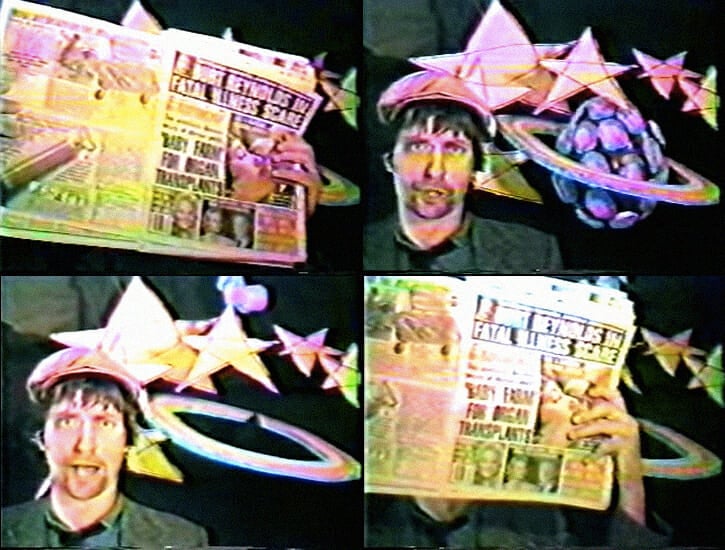Unpopular Content
Outsmarting the YouTube algorithm Stills from ANGRY AT THE UNIVERSE | YouTube
Stills from ANGRY AT THE UNIVERSE | YouTube o
r
d
F
a
c
t
o
r
y
In 2011, Everest Pipkin and Zo? Sparks, two artists living in Austin, Texas, started collecting unremarkable, seldom-viewed videos off YouTube: a man in a green cardigan imitating bird whistles. Kermit the Frog at a shopping mall meet and greet.?A Swedish woman drinking beer in the bath. Pipkin and Sparks arranged the videos into a two-hour long playlist and screened it for friends as one continuous movie entitled, “Snowfall DESTROYS Three Cars.” (It was named after one of the videos in the movie, in which a huge pile of snow slides off an apartment block somewhere in Russia and buries three parked cars below.)
The artists’ curatorial experiment came at a turning point in YouTube’s short history. The platform?was no longer just a user-friendly holding place to upload videos, as it had been in its formative years. Nor was it the streamlined, algorithmic influence machine that it is now. The platform?was somewhere in between, in the midst of its “viral video” stage, when users spent a good deal of time?“hunting” for the best content and sharing links with friends.
More

404 Page Not Found
By Kate WagnerYouTube’s engineers were taking advantage of this burgeoning virality and had implemented a recommendation system that would?promote the most popular videos (or ones that seemed poised to become them). But Pipkin and Sparks preferred the weirder corners of YouTube and wanted to celebrate those videos that did not, and would never, go?viral.?“Snowfall DESTROYS Three Cars” was an homage to this unpopular content, which, as Sparks put it,?brought the viewer “closer to the metal of life . . . allowing you to see an angle on being alive that viscerally resonates with you on contact although you’ve never imagined it.”
Over the next four years, Pipkin and Sparks made new editions of “Snowfall DESTROYS Three Cars,” and screened them at several museums and small art festivals.?But each time,?it grew harder for the artists to navigate back to those obscure corners of YouTube.
This is because YouTube had introduced a feed and redesigned their recommendation algorithm to optimize for “watch time” instead of popularity,?promoting content that kept the viewer glued to the screen. These design changes were supposed to “personalize” the viewing experience, and serve up relevant, enjoyable content from the ever-growing Borgesian archive. But in reality, YouTube was?privileging a frictionless, addictive viewing experience in order to sell ads. This singular focus?on monetizable and marketable content buried the banal videos that Pipkin and Sparks loved even deeper. In their place emerged a cadre of homegrown YouTube “influencers” like PewDiePie, who were propped up by partnerships with outfits like Maker Studios and appeared preternaturally attuned to the demands of the algorithm. They were willing to do anything, and say anything, to satisfy its rapacious appetite for engagement. Frustrated with the platform, Pipkin and Sparks gave up the curatorial project in 2015.?
YouTube was?privileging a frictionless, addictive viewing experience in order to sell ads.
Since then, the algorithm has only strengthened its hold on how we watch—and how “creators” produce—YouTube. As of August 2017, more than 70 percent of viewing time was being driven by automatic recommendations. And the content that gets promoted is even more aggressively selected for engagement gravity, meaning the sensational and divisive gets pushed to the top of the feed. One unintended consequence of YouTube’s endless pursuit to sell more ads, Zeynep Tufekci has argued, is that the platform has become “one of the most powerful radicalizing instruments of the twenty-first century,” pushing unsuspecting viewers deeper and deeper into politically unhinged, conspiratorial rabbit holes just to keep their attention for a few more minutes.
For Pipkin, a less politically salient though personally unsettling?consequences of the rise of personalized content optimized for engagement has been the gentrification of their own YouTube experience. While the politics has become more outrageous, the pranks more?insane, the fails more devastating, Pipkin also feels that YouTube has become more like TV— samey and aesthetically dead.
“I once had a profound relationship with this platform,” they told me. “I loved the banal and weird YouTube because for me that was where the promise and goodness and real human experience was.?It was soothing, a part of my artistic practice. But the recommendation algorithm took that from me, and now just cycles me back to whatever conspiracy theory or Vine compilation it thinks I might want to watch.”?
Earlier this year Pipkin developed a counter-strategy, a way to circumvent the algorithms and navigate back into the banal depths of YouTube via an unlikely source: the default file name.?A default file name is the string of characters a camera generates for a video before it is renamed, like IMG 0020 or 4752.MOV. Pipkin told me that their personal YouTube channel is filled with these unchristened videos, which are generally little moments that Pipkin records and then uploads for their own later reference without bothering to edit the default metadata.?
Pipkin, who makes software art as well as pen and ink drawings, figured that if they were uploading these unnamed videos, others must be too. So, they wrote a program that could generate a default file name at random and then automatically search for it on YouTube. They discovered that there were millions of these innominate videos, and that most of them were also raw, seldom seen recordings that captured the precise aesthetic that they and Sparks had created with their curated YouTube movies years earlier. By narrowing the search to videos that came out of a camera with a default name, Pipkin found a way to bypass the algorithm and rediscover YouTube’s more intimate pockets.
The program was intended for personal use, but Pipkin was taken enough by its output that in March of this year, they launched a website called Default Filename TV where anyone can watch this stream of unpopular YouTube videos.?I stumbled onto a link to Default Filename TV one Sunday afternoon while procrastinating on Twitter. Clicking through, I found myself watching four middle school students present a Rube Goldberg machine at a science fair. Then I saw a Russian family using buckets to clear water out of their kitchen during a flood, then two blue and purple Siamese fighting fish placed in adjacent glasses of water trying vainly to attack each other. I saw a first waltz at a wedding in Nairobi, and a performance at the Pacific Northwest Teen Square Dance Festival.?My?favorite unpopular video was a British man in his living room taste testing some Corky’s Sour Cherry schnapps. (He takes a sip, grimaces, and says, “Yuck. Tastes a bit like cherries.”)
The?experience reminded me of how I used to watch YouTube back in 2011, when there was still a sense of personal discovery and interpersonal curation, when there was a premium on finding untapped resources of?unintentional weirdness and sharing it with friends to prove your internet prowess. I remember somehow stumbling upon this video of?“Taxi Dave,” a cab?driver from Sacramento who decided to upload a promotional video of him cutting loose to LMFAO in an empty parking lot. (It now has over 19,000 views, but at the time was relatively unknown.) The experience of watching YouTube then was less personalized, but more personal. Default Filename TV manages to recreate that sensibility.?
There are others, like Pipkin, who are experimenting with ways to navigate to the more obscure parts of the Internet as algorithmic creep renders them ever more inaccessible. Youhole.tv, Incognitube, and Astronaut.io?also provide portals to unpopular YouTube videos, and Forgotify?generates a playlist of tracks on Spotify that have never, or only partially, been listened to. (I used it to listen to a track by Abdullah Papur, a Turkish folk singer, followed by a?ukulele song called?“Why I Hate the French” by Jo Stephenson.) There is something about these projects that gestures toward what Walter Benjamin had hoped to achieve with his Arcades Project: they are assemblages of cultural detritus that together reveal something truer, more primal about the travel of human life than, that which is selected by the “great men of history,” or in our digital moment, the great recommended content of the internet.
For?Pipkin, Default Filename TV is more than internet dilettantism; it’s a tool that can momentarily subvert the?logic of the attention economy. They explained to me that if I left?the website?running on my YouTube account over the weekend, I’d be introducing some “absolute noise” into my viewing habits. “This makes it harder for the algorithm to know what you like,” Pipkin said. “For me this is appealing because at the moment, I am very frustrated with YouTube’s vision of me.”
Pipkin is not alone. In the past couple of years, an outpouring of resentment and anger has been levelled at these major platforms for destroying our hearts and minds and reconfiguring us as receptacles of data with twenty-four potential milkable hours. One response has been the rise of “digital wellness,” a movement (read: a bumper crop of books and apps) that encourage us to “opt out” and reclaim control of our time.
Default Filename TV is more than internet dilettantism; it’s a tool that can momentarily subvert the?logic of the attention economy.
Pipkin’s resistance strategy, however, does not demand that you “opt out” of the internet altogether and go sit in a forest far away. That kind disengagement implies that there is something wrong with the ideaof the internet, rather than with the economic model that controls it. Instead, Pipkin’s project holds on to the promise that somewhere inside the algorithmic labyrinth that now indexes and organizes the?internet for the financial benefit of a few megalomaniacal companies, there is still?a more unmediated expression of the human experience that subverts the logic of platform internet—and Default Filename TV can help take us there.
To be sure, Default Filename TV is only a minor act of aesthetic resistance against the tyranny of algorithms, and the economic model that built them, a symbolic gesture, kind of like anti-facial-recognition makeup.?But at this degraded stage, I’m happy to take whatever I can get. Just recently, along with the Vine?compilations, extreme oceanic events, and stand-up comedy acts, my YouTube recommendations have included increasingly violent videos. It started with skiing accidents, then outtakes from old episodes of Jackass, and finally a genre of video called?“Skaters vs Haters,” in which skaters get into fistfights with security guards, cops, and various angry passersby. When one of these?pops up in my YouTube feed,?I feel guilty,?as if the algorithm knows some dark, violent desire in my subconscious that I don’t.
So, I took Pipkins?advice?and left?Default Filename TV running on my YouTube to see?what?happened. After two days, the skiing accident videos had disappeared from my recommended videos, replaced with something even more disturbing: “Jordan Peterson DESTROYS overconfident Leftist interviewer.”